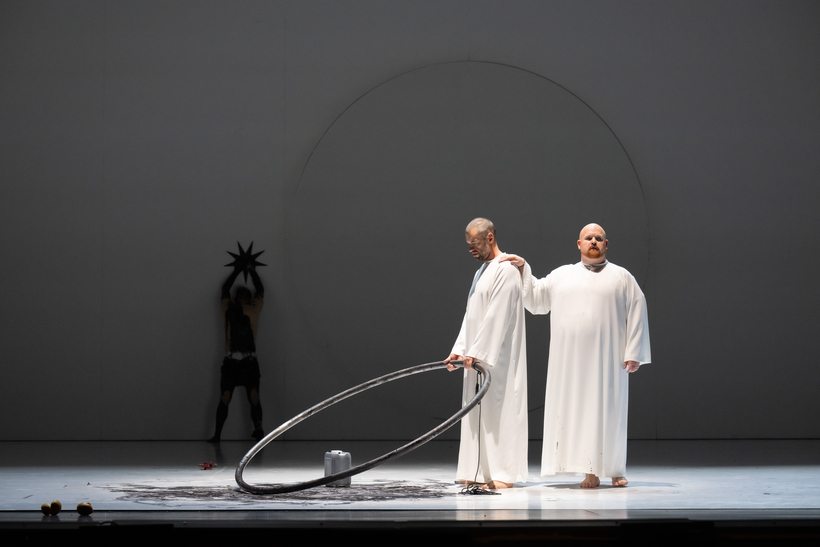You don’t see much lip-synching at the opera. But the Rheingold filmed live at La Monnaie, Brussels, this fall, includes quite a bit. The giants Fasolt and Fafner take turns singing—and mouthing each other’s text when they’re not. A pale, crowned choirboy of a Wotan holds forth in silence as his grown-up lookalike temporarily thunders from the wings. No, these passages aren’t the key to Romeo Castellucci’s magic-lantern of a show—there is no key—but the subliminal shiver of the shamanic lingers long past the final curtain.
All the world’s a stage, is it? Not according to Castellucci, director and designer of sets, costumes, and lighting for a vast oeuvre of phenomenally intricate theatrical moonshots. “Reality doesn’t exist in the theater,” Castellucci insists. “If there is reality, there is no theater.” Rather than box himself in with “concepts” or “messages,” he unfurls images sprung from the depths of a Jungian well, dissolving history, transcending cultures. “I want to create a problem for the spectator,” Castellucci has said. “That problem, I think, is a gift.”
Taken in that spirit, his Rheingold—the down payment on a complete new production of Richard Wagner’s four-part “Ring” cycle—certainly gives a viewer lots to take onboard: colossal bric-à-brac from classical antiquity, metal beams and heavy machinery pointing to the Industrial Age, billboard-size blowups of legendary Wagnerians, a numinous headless Buddha. On the other hand, the totemic props Wagner builds his myth on are nowhere in sight. No lump of magic gold. No ring. No helmet to shift shape with. No spear for enforcing a contract.
Wotan, Fricka, and the rest of Wagner’s Norse gods make their entrance robed in Orthodox black, teetering on a sea of writhing human bodies. At the far end of their journey, now in ascetic Himalayan white, they fall backward, one by one, into a void, somehow suggesting an escape into nirvana. Only the trickster demigod Loge stays behind—Loge who first bounded onstage bearing live flame in his open palm.

Wotan, the protagonist of Wagner’s epic, is an ambivalent figure. With his dark, buzzy timbre, firm control of line, and upright bearing, the Hungarian bass Gábor Bretz projects the god’s authoritative façade yet also something of his duplicity. As Alberich, Wotan’s demonic rival for world dominion, the American baritone Scott Hendricks is hideous to look at but good to listen to, forgoing customary snarling to reveal his music’s bitter beauty. It’s telling that when he’s bested and tortured, the disfiguring prosthetics fall away to reveal the naked, suffering human being within.
The Scottish tenor Nicky Spence relishes the glint and ironic romance in the showy role of Loge and lobs paintballs with deadly accuracy. The conductor Alain Altinoglou navigates the Technicolor score with a steady hand throughout, but starting with the scary orchestral interlude that whisks us from the gods’ open-air mountaintop to Alberich’s smoky forced-labor camp underground, he seriously ups his game.
Romeo Castellucci’s production of Das Rheingold is available for streaming on YouTube through December 31. The “Ring” cycle at The Royal Theatre of La Monnaie continues with Die Walküre in January of the new year, Siegfried the following September, and Götterdämmerung in January 2025. A co-production with the Liceu, in Barcelona, Castelluci’s “Ring” transfers to that company beginning in the 2025-26 season.
Matthew Gurewitsch writes about opera and classical music for AIR MAIL. He lives in Hawaii

